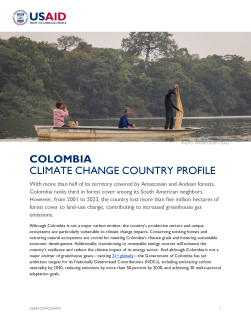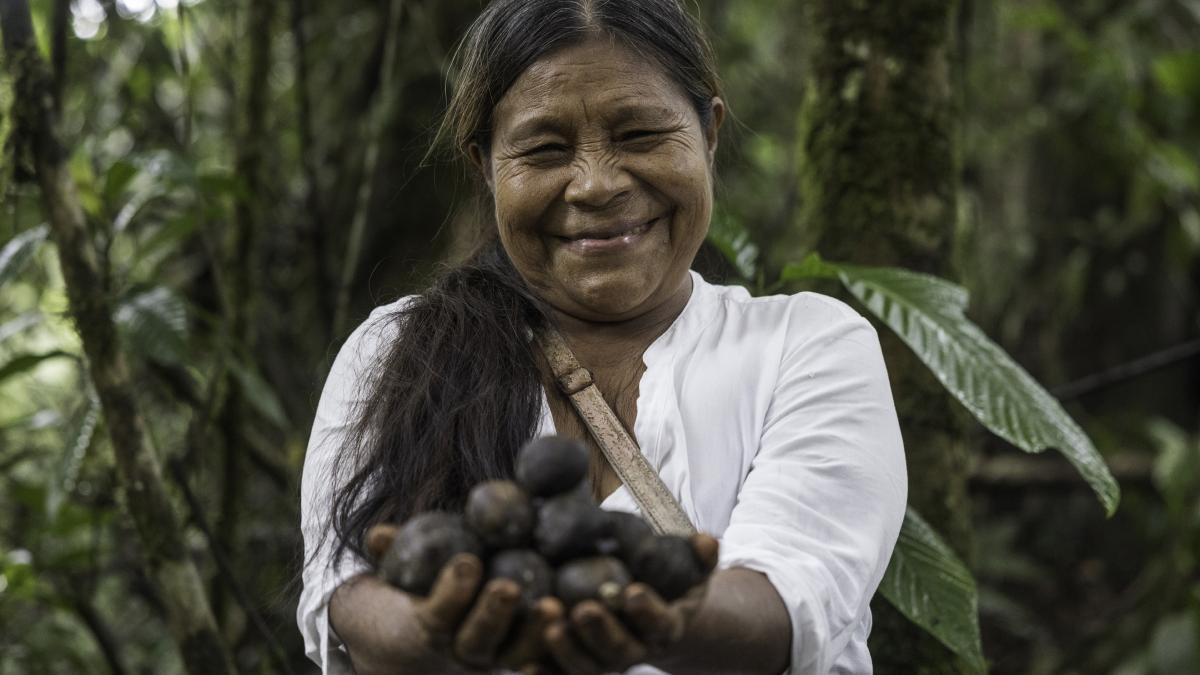Colombia is not a major carbon emitter; however, it is particularly vulnerable to the impacts of climate change. Conserving standing forests and restoring natural ecosystems contribute to climate goals and generate sustainable economic development. Transitioning to renewable energy increases the country’s resilience and mitigates the sector’s climate impact.
Although Colombia is not a major carbon emitter, the country’s productive sectors and unique ecosystems are particularly vulnerable to climate change impacts. Conserving existing forests and restoring natural ecosystems are crucial for meeting Colombia’s climate goals and fostering sustainable economic development. Additionally, transitioning to renewable energy sources will enhance the country’s resilience and reduce the climate impact of its energy sector. And although Colombia is not a major emitter of greenhouse gases—ranking 31st globally—the Government of Colombia has set ambitious targets for its Nationally Determined Contributions (NDCs), including embracing carbon neutrality by 2050, reducing emissions by more than 50 percent by 2030, and achieving 30 multi-sectoral adaptation goals.
In 2012, the Government of Colombia developed a National Adaptation Plan. Over the past ten years, it has also created adaptation plans for key sectors, including agriculture, biodiversity, health, and water, and developed adaptation indicators to monitor progress. Currently, 54 percent of Colombia’s greenhouse gas emissions result from agriculture, forestry, and other land-use sectors, while nearly 35 percent of total emissions are produced by the energy sector, including transportation.
Vital components of Colombia’s economy, such as hydroelectricity production—which generates two-thirds of the country’s electricity—and agriculture, are both highly vulnerable to climate change. Meanwhile, climate variability, irregular rainfall, and prolonged droughts are disproportionately impacting the traditional ways of life of the country’s rural and ethnic communities.
Government of Colombia Climate Priorities
In November 2020, the Government of Colombia announced ambitious greenhouse gas emission reductions and other commitments to increase climate resilience as part of the country’s updated NDC. These climate mitigation and adaptation targets included:
- An energy transition plan to include: 1) solar, wind, biomass, and small hydro projects; 2) the development of sustainable mobility solutions; 3) the launch of new technologies such as green hydrogen and geothermal energy; and 4) the adoption of a carbon-neutral policy for the sector;
- An enhanced Colombian carbon market and establishment of a Cap and Trade Emissions Trading Scheme (Since 2017, Colombia's carbon tax offset mechanism has traded 111 million tons of verified emissions reductions); and
- An incorporation of climate change risks and innovative adaptation actions into priority economic sectors, such as transport, energy, agriculture, housing, health, commerce, tourism, and industry.
In August 2022, a new presidential administration, led by President Gustavo Petro, restated that climate change policy will remain among the Government of Colombia’s top priorities. The main strategies the government is currently advancing include:
- A 10-year strategy to invest USD $200 million to reach net zero deforestation by 2030;
- Fighting deforestation in 28 deforestation hotspots in the Amazon through participatory approaches that include communities, and using strategies that address illegal activities, strengthen the capacity of the justice sector and local institutions, and exercise territorial control;
- Accelerating forest restoration to achieve at least 750,000 restored hectares while decreasing deforestation rates;
- Creating a Climate and Biodiversity Fund to consolidate funding sources, catalyze new sustainable financing mechanisms, and improve transparency and accountability;
- Improving carbon market regulation to ensure additionality, transparency, participation, and just prices;
- Accelerating NDC implementation and elevating the importance of climate adaptation, particularly as it relates to water management;
- Continuing with the national transition to renewable energy by promoting international investments to harness Colombia’s wind and solar resources and focusing on “democratization” of the country’s energy sector through universal and affordable access; and
- Accelerating the transition to electric mobility in public transport as a major emissions reduction strategy.
USAID’s Climate Change Program: Objectives and Results
USAID supports the Government of Colombia’s development and climate priorities through a series of programs and partnerships across its climate adaptation, renewable energy, and natural climate solutions activities. USAID promotes integrated approaches to reduce emissions and build resilience to climate change into its rural economic development programs and will initiate new partnerships with the private sector and civil society to help the country achieve its ambitious greenhouse gas emission reduction targets.
Adaptation
USAID supports improved environmental management of Colombia’s most threatened ecosystems, including the Orinoquía flooded savannas, Caribbean dry forests, Andean páramos, and the Amazon and Pacific coast tropical forests. USAID is improving Colombia’s climate resilience through increased access to information to reduce climate-related risks, promotion of climate-smart agricultural practices, and more robust support for ecosystem conservation and restoration, as well as for the expansion of vegetative cover to protect soil and conserve water. The following results represent the efforts of multiple USAID activities implemented through FY 2023.
Key Results
USAID has helped:
- Strengthen climate resilience through nature-based solutions by improving the natural resource management of 289,000 hectares in the Bajo Cauca region; more than 5,830 people were trained on sustainable natural resource management, of whom 52 percent were women
- Increase economic incentives for conservation, such as commercial agreements for agricultural products and payment for ecosystem services to protect more than 29,000 hectares of land
- Protect water sources and biological corridors through the establishment of forage banks to prevent soil degradation and improve livestock nutrition on 140,000 hectares of land dedicated to dairy and beef production
Key Ongoing Adaptation Programs
Productive Nature
This activity promotes partnerships between the private sector and local communities to advance biodiversity conservation and protect nature’s services. The activity uses a market systems strategy to favorably influence business models, including local startups, by implementing nature-based solutions within agricultural, cosmetics, and energy value chains. Nature-based solutions enhance the management, protection and restoration of ecosystems, safeguarding environmental services and boosting local climate resilience. Using a landscape approach, the activity conserves biologically significant ecosystems in the Andean, Caribbean, and Orinoquía regions.
Sustainable Economic Transformation (SET)
SET aims to promote equitable and environmentally sustainable growth and development. This activity focuses on enhancing the competitiveness, diversification, and resilience of rural economies in targeted areas. It seeks to strengthen local businesses’ ability to adapt to climate change and build resilience against potential climate shocks. SET will improve planning by helping communities, public institutions, and private actors use the best available climate information and technologies for decision-making. This collaboration will help define local investment priorities and develop regional development plans that support climate adaptation.
The Comprehensive Action for Climate Change Initiative (CACCI)
CACCI assists the Government of Colombia in accelerating the implementation of the country's targets under the Paris Agreement. CACCI supports the coordination and monitoring of the NDC Implementation Plan and generates inputs to update this contribution in 2025 and construct a new NDC for 2050. CACCI also focuses on identifying adaptation initiatives within national, territorial, and private sector entities to align them with existing instruments, strategies, and planning tools.
Renewable Energy
About two-thirds of Colombia’s electricity is generated by hydropower, a renewable energy source that is nonetheless highly vulnerable to climate change since changes in precipitation patterns and prolonged drought can lead to energy shortages, price increases, and increased dependence on fossil fuels (coal and natural gas) for electricity generation. Colombia is a major exporter of thermal coal, which contributes significantly to greenhouse gas emissions in the energy sector. USAID promotes transitioning to low-cost, diversified renewable energy sources in the Colombian national market through planning, integration, and operational support. To this end, USAID partners with the Government of Colombia, private companies, and local organizations to develop, test, and scale capacity-building and co-investment models.
For example, USAID supports market-based policies to develop Colombia’s wind and solar potential and provides U.S. expertise to help craft policy and regulatory frameworks geared toward decarbonizing Colombia’s economic sectors. USAID also supports developing capacity building and job training programs for local youth, particularly in rural and conflict-affected areas and is developing blended finance models to promote private sector investment in renewable energy. The following results represent the efforts of multiple USAID activities implemented through FY 2023.
Key Results
USAID has helped:
- Assist the Government of Colombia in implementing its renewable energy auction program, resulting in the award of 15-year power purchase agreements to 22 new solar and wind projects; these projects will increase renewable energy generation by 2,100 megawatts, leverage $2 billion in private sector investment between 2023 and 2026, and create approximately 44,000 new jobs
- Provide strategic renewable energy training to 65 young energy sector professionals—68 percent of whom were women—to further Colombia’s ability to integrate its growing renewable energy supply into the national grid
- Pilot a renewable energy training program addressing the professional development needs of Indigenous youth; the program trained 37 young leaders from Wayuu Indigenous communities in La Guajira to participate effectively in the growing renewable energy job market and in community consultations related to new renewable energy projects
- Support Providencia Island’s natural disaster recovery efforts and advance its renewable energy transition through the creation of the Providencia Island Renewable Energy Master Plan; to design and establish the island’s new solar power plant—piloting a model that can be replicated as the country moves forward with energy diversification plans—USAID partnered with the Ministry of Mines and Energy, and Ecopetrol, Colombia’s largest hydrocarbon company
Key Renewable Energy Programs
Renewable Energy for Peace (RE4P)
RE4P is a global development alliance that supports the planning, building, and operation of mini solar energy grids to enhance the growth of productivity clusters in conflict-affected communities with no energy access. The energy grids and accompanying technical assistance to strengthen the energy security of producers and rural entrepreneurs will enable priority communities to access affordable, clean energy needed to increase productivity, improve well-being, and foster social stability. This program also seeks to leverage private sector investment in rural energy communities through innovative blended finance mechanisms.
The U.S. National Renewable Energy Laboratories (NREL) Partnership
This program provides policy, planning, modeling, and deployment support to national energy entities within the Government of Colombia to deliver clean, reliable, and affordable power.
The Scaling Up Renewable Energy Program II (SURE II)
SURE II focuses its technical assistance to support the Government of Colombia’s ambitious efforts to transition to renewable energy, mitigate energy sector emissions, and position indigenous and Afro-Colombian communities to better participate in the burgeoning renewable energy economy.
Natural Climate Solutions
Land-use change is Colombia’s major source of greenhouse gas emissions. USAID helps reduce deforestation and forest degradation through sustainable forestry, sustainable agriculture, and community land management to address the root causes of land-use change, promote sustainable livelihoods, and increase the effectiveness of environmental policies. Protecting forests and other key ecosystems sustains livelihoods, mitigates climate change risks, and maintains environmental services like biodiversity conservation, carbon capture, and water purification. The following results represent the efforts of multiple USAID activities implemented through FY 2023.
Key Results
USAID has helped:
- Develop and implement eight projects focused on reducing emissions from deforestation and forest degradation (REDD+) by working with 18 Afro-Colombian communities and one Indigenous community; the projects protected 500,000 hectares of Pacific forests, which helped generate and sell more than 6 million verified carbon units (VCUs) in the carbon market, valued at $27.9 million
- Promote and strengthen conservation enterprises within the Amazon region, generating livelihood co-benefits (both monetary and non-monetary) for more than 4,400 people
Key Natural Climate Solutions Programs
Colombia Forests and Wetlands
This activity promotes the transfer of forest and natural resources management expertise from the U.S. Forest Service to local governments and communities, including technical assistance to increase public forest governance, improve wildfire management, and strengthen carbon monitoring to conserve biodiversity and reduce carbon emissions. The activity also supports the SilvaCarbon and Sustainable Wetlands Adaptation and Mitigation Program (SWAMP) to monitor and report carbon emissions, and strengthens the Government of Colombia’s capacity to incorporate carbon data into land policy, management, and strategy development processes.
Amazon Alive
This activity strengthens the capacity of national and local institutions to improve environmental crime prevention and prosecution. These efforts reduce deforestation and increase forest conservation while promoting legal economic alternatives for Amazonian communities. The activity prioritizes interventions in areas that are critical to maintaining biodiversity connectivity and that are adjacent to natural parks, forest reserves, and indigenous territories.
Land for Prosperity
Land for Prosperity works with community, public, and private sector actors to consolidate a national land formalization model to address challenges stemming from informal land rights—a key driver of deforestation. The activity implements Colombia’s multipurpose cadaster and awards land-use rights in areas previously designated as forest reserves in the Amazon as an incentive to promote sustainable economic practices and reduce deforestation. Through these efforts, USAID supports the Government of Colombia’s expansion of Chiribiquete National Park, which is Colombia’s largest protected area and spans approximately 4.2 million hectares of land (or about 16,600 square miles).
Destination Nature
This activity conserves biodiversity and reduces greenhouse gas emissions by supporting rural communities in making a living from sustainable nature tourism. With a focus on regenerative nature tourism, Destination Nature works with local communities to build business models that have a positive impact on sustainable land use, reduce ecosystem degradation, and protect biodiversity. The activity uses a landscape approach to work on 14 nature tourism corridors in six regions in Colombia that have strong nature tourism potential yet face significant environmental threats. The work focuses on improving nature tourism governance, enhancing the commercial, social, and environmental sustainability of tourist sites, and promoting sustainable land practices at scale.
Sustainable Agriculture Activity (SAA)
SAA supports both adaptation and mitigation co-benefits through the expansion of lawful, profitable, and climate-smart agricultural (CSA) business models. The activity encourages producers to adopt CSA models—such as agroforestry and silvopastoral models—since the use of CSA by producers supports conservation, reduces emissions from land-use change, increases carbon sequestration, and improves the adaptive capacity of local communities.
Golden Land (Tierra Dorada)
This activity aims to reduce greenhouse gas emissions, promote biodiversity conservation, and support legal livelihoods in regions of Colombia where the expansion of artisanal and small-scale mining (ASM) has degraded ecosystems. Tierra Dorada promotes initiatives to reduce deforestation and emissions from ASM operations, while supporting reclamation and rehabilitation of land degraded by mining. The activity also supports alternative economic opportunities within mining communities by fostering legal markets, promoting greater social inclusion, and improving environmental stewardship.
Climate Finance
USAID partners with private companies, financial institutions, donors, and the Government of Colombia to enhance the enabling environment and attract investment for scaling up renewable energy adoption in off-grid regions. USAID’s climate finance efforts not only increase the resilience of vulnerable populations, but also support the growth of entrepreneurs who sustain livelihoods in forested areas.
Expected Results:
USAID expects to:
- Mobilize or leverage $450 million in climate finance
- Help reduce, sequester, or avoid at least 20 million tons of greenhouse gas emissions through climate-smart projects and businesses
- Accelerate the development of 750 businesses or climate-smart projects
- Support the passage of at least 20 laws, policies, regulations, or standards that enable climate finance formally adopted, proposed, or implemented
- Improve the capacity of 30 institutions to address climate change
- Develop the first free-access financed emissions accounting tool in Latin America as an important step in guiding financial institutions in implementing their net-zero strategies
Key Climate Finance Programs
Invest for Climate (IN4C)
IN4C aims to mobilize investments from both the public and private sectors into projects that increase Colombia’s resilience to climate change impacts and promote a sustainable, inclusive, and low-carbon economy. The activity designs innovative financial solutions to upscale the funding allocated to initiatives that promote clean energy, sustainable agriculture, forest protection, and reduced deforestation. In addition, IN4C incubates and accelerates businesses that bring adaptation solutions to communities, while structuring projects that will help build resilience in regions of the country that are particularly vulnerable to climate change.
Sustainable Banking Alliance
This activity partners with the banking sector to accelerate the implementation of their roadmap to net zero by developing a free-access emissions accounting tool and providing a capacity-building program for banks to expand their green portfolio and systematically measure and report climate metrics.




